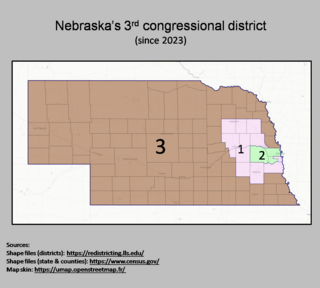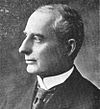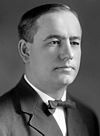The 20th congressional district of Ohio was created after the 1840 census. It was eliminated in the redistricting following the 1990 census, and redistricted and renumbered as the 10th district.
The 21st congressional district of Ohio was a congressional district in the state of Ohio. It was eliminated in the redistricting following the 1990 census.
The 23rd congressional district of Ohio was eliminated as a result of the redistricting cycle after the 1980 Census. The district had been created after the elimination of Ohio's at-large congressional district after the 1950 election.

Nebraska's 1st congressional district is a congressional district in the U.S. state of Nebraska that encompasses most of its eastern quarter, except for Omaha and some of its suburbs, which are part of the 2nd congressional district. It includes the state capital Lincoln, as well as the cities of Bellevue, Fremont, and Norfolk. Following the 2010 United States Census, the 1st congressional district was changed to include an eastern section of Sarpy County; Dakota County was moved to the 3rd congressional district.

Nebraska's 3rd congressional district is a congressional district in the U.S. state of Nebraska that encompasses its western three-fourths; it is one of the largest non-at-large districts in the country, covering nearly 65,000 square miles (170,000 km2), two time zones and 68 counties. It includes Grand Island, Kearney, Hastings, North Platte, Alliance, and Scottsbluff. Additionally, it encompasses the Sandhills region and a large majority of the Platte River.

Louisiana's 7th congressional district was a congressional district in the U.S. state of Louisiana located in the southwestern part of the state. It last contained the cities of Crowley, Eunice, Jennings, Lafayette, Lake Charles, Opelousas, Sulphur and Ville Platte.

South Dakota's at-large congressional district is the sole congressional district for the state of South Dakota. Based on area, it is the fourth largest congressional district in the nation.
South Dakota's 2nd congressional district is an obsolete district. It was created after the 1910 census and was eliminated as a result of the redistricting cycle after the 1980 Census. Members were elected at-large until the formation of individual districts after the 1910 census. From 1913 until 1933, the 2nd district covered much of northeastern South Dakota, including the cities of Aberdeen, Brookings, Huron, and Watertown. When South Dakota's 3rd congressional district was eliminated after the 1930 census, the 2nd district was relocated to cover all of the counties in South Dakota west of the Missouri River. Population changes eventually moved the district's boundaries further east. During the 97th Congress, it covered all but the 21 easternmost counties in the state.
Ohio's 8th congressional district sits on the west side of Ohio, bordering Indiana. The cities of Hamilton, Fairfield, Middletown, Springfield, Eaton, Greenville, Piqua, and Troy are part of the district. The district was represented by Republican John Boehner, the 53rd Speaker of the United States House of Representatives. On September 25, 2015, Boehner announced his resignation from the speakership and retirement from Congress, which became effective on October 31, 2015.

The 16th congressional district of Ohio is an obsolete United States congressional district last represented by Representative Anthony Gonzalez (R). It was last located in the northeast of the state, covering Wayne County and with arms extending north into the suburbs of Cleveland, and east into Greater Akron and Stark County. The district was eliminated upon the swearing in of the 118th United States Congress on January 3, 2023, as the reapportionment after the 2020 census reduced the number of congressional districts in Ohio to fifteen.
South Dakota's 1st congressional district is an obsolete congressional district that existed from 1913 to 1983.
From its statehood in 1816 until 1823, Indiana was allocated only one representative, who was elected at-large. During the 43rd Congress, from 1873 to 1875, Indiana elected three of its thirteen representatives to the United States House of Representatives at-large from the entire state.
Pennsylvania's 31st congressional district was one of Pennsylvania's districts of the United States House of Representatives. It existed from 1903 to 1953.
Pennsylvania's 33rd congressional district was one of Pennsylvania's districts of the United States House of Representatives.
Oregon's at-large congressional district is a former United States congressional district. During its existence, Oregon voters elected a Representative of the United States House of Representatives at-large from the entire state.
Alabama's 9th congressional district was formerly apportioned to portions of central and western Alabama from 1893 until 1963 when the seat was lost due to reapportionment after the 1960 United States Census.
North Dakota's 3rd congressional district is an obsolete congressional district in the state of North Dakota that was created by reapportionments in 1913, and eliminated by the reapportionments of the 1930 census in 1933. The district consisted of the western part of the state, and was made up of following counties: Divide, Burke, Renville, Ward, Mountrail, Williams, McKenzie, McLean, Dunn, Mercer, Oliver, Billings, Stark, Morton, Hettinger, Bowman and Adams.
Alabama's at-large congressional district was a congressional district for the United States House of Representatives in Alabama active at various times from 1819 to 1965. Alabama became a state in 1819, and its single representative to the 16th and 17th Congresses was elected at-large. For the 27th Congress, all five of Alabama's representatives were elected at-large, before the state gained a representative from the 1840 census. In the 43rd to 44th Congresses, the seventh and eighth representatives gained in the 1870 census were elected at-large. For the 63rd and 64th Congresses, Alabama elected the tenth of its apportioned representatives, gained in the 1910 census, at-large from the entire state. For the 88th Congress, after the state lost one representative in the 1960 census, Alabama once again elected all of their representatives at-large.
Alabama's 10th congressional district is an obsolete district which existed from 1917 until 1933. Its sole representative was William B. Bankhead.
Pennsylvania's 22nd congressional district was one of Pennsylvania's districts of the United States House of Representatives.







